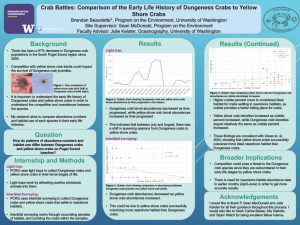Crab Battles: Comparison of the Early Life History of Dungeness Crabs to Yellow Shore Crabs.
There has been a 97% decrease in Dungeness crab populations in the South Puget Sound region since 2005. The group I work with (Pacific Northwest Crab Research Group) is taking on the responsibility to understand why this is the case. The purpose of this study was to see if larval patterns in Dungeness crabs (Cancer m.) and yellow shore crabs (hemigrapsus o.) have a clear connection to the early benthic patterns in the two species. During my time with PCRG, I recorded abundances of Dungeness crab larvae and shore crab instars using a light trap to catch the two species. I then conducted a form of research called nearshore intertidal surveying to record abundances of Dungeness crab instars and yellow shore crab adults in nearshore habitats. The results of my research showed yellow shore crabs being more abundant than Dungeness crabs in both the light trap and nearshore habitats in the months of July and August, which points towards yellow shore crabs outcompeting Dungeness crabs for ideal nearshore habitats in their early benthic phase during those months. The significance of finding the connection between the early life histories of these two crab species is that it shows how the two species interact in their early life histories. Understanding the interaction between the two species in their early life histories is vital because it can answer important questions such as how the timing of abundance plays a role in the coexistence of both Dungeness crabs and yellow shore crabs.
